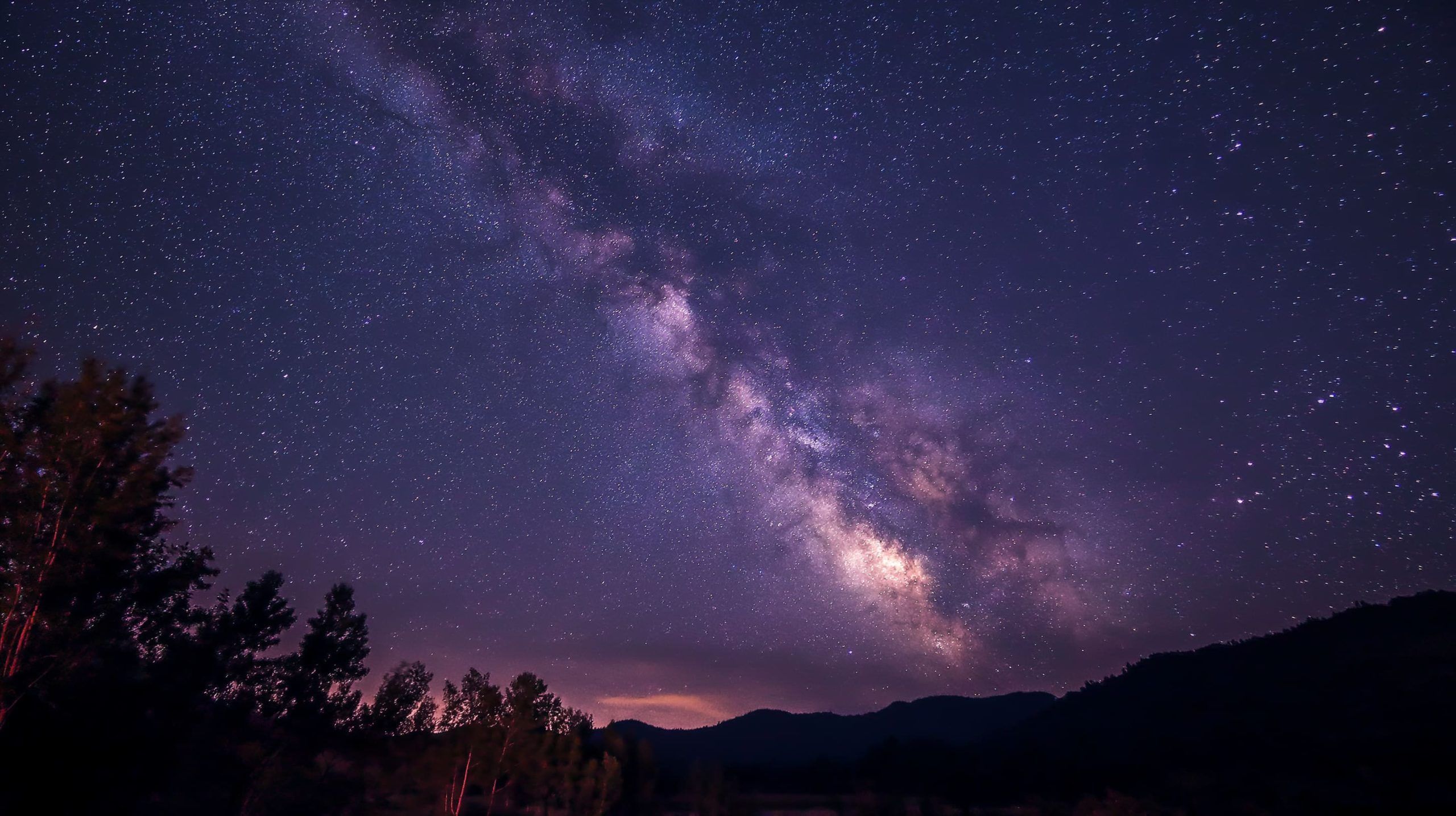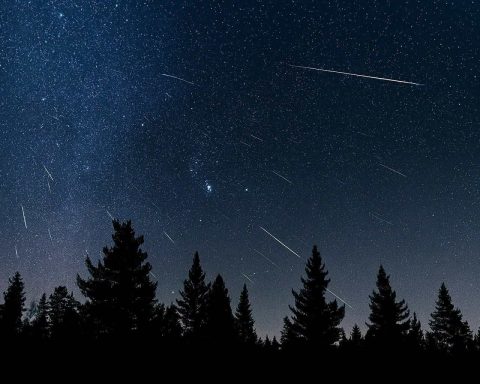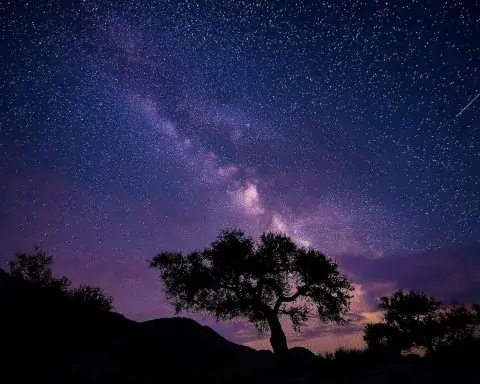- The Perseid meteor shower peaks around August 12–13, 2025, with a bright Moon at about 84% full that reduces typical rates from 50–75 meteors per hour to about 10–20 per hour or fewer.
- The best Perseid viewing is after dark, especially between midnight and dawn around 2:00–4:00 a.m. local time when the Perseus radiant is highest, per NASA.
- The Perseids are debris from Comet 109P/Swift-Tuttle, whose last near-Earth approach was in 1992.
- On August 13–14 the Moon is waning gibbous at about 75–80% illumination, rises in mid-evening, and its brightness washes out fainter stars and meteors.
- On August 8–9 a moderate G2 geomagnetic storm (Kp ~6) produced vivid aurorae across northern latitudes of Canada and the northern U.S., with NOAA forecasting possible auroras as far south as Illinois.
- As of August 13–14, Earth’s magnetic field has settled and no new geomagnetic storms are expected, with a Kp around 2 indicating very quiet conditions.
- With a Kp around 2, auroras will be faint and confined to extreme northern regions such as northern Canada, Alaska, Scandinavia, and Iceland.
- Late August is expected to bring a stronger-than-average aurora season again at high latitudes like Iceland and Greenland as nights lengthen toward the fall equinox.
- On the mornings of August 12–13, Venus and Jupiter underwent a close conjunction about 1° apart around 3:00–4:00 a.m. local time, rising together in the eastern sky.
- Saturn (magnitude +0.5) in Pisces and Neptune (magnitude ~7.8) are near each other this month, with the Moon at 86% illumination passing about 3° from Saturn on August 12 and the pair visible together until dawn on August 13–14.
Meteor Shower Alert: Perseids Peak Under a Bright Moon
The Perseid meteor shower – one of the year’s most beloved sky shows – is reaching peak activity around August 12–13. However, a waning gibbous Moon (~84% full) will flood the night sky with light, dramatically reducing the number of visible meteors [1] [2]. Under dark, moonless skies, observers might normally catch 50–75 Perseids per hour at the peak. This year, “you’re probably going to see 10 to 20 per hour or fewer, and that’s because we have a bright Moon in the sky washing out the fainter meteors,” explains Bill Cooke, lead of NASA’s Meteoroid Environment Office [3]. In other words, only the brightest Perseid fireballs will shine through the lunar glow [4].
When and how to watch: Perseids can appear any time after dark, but the best viewing is between midnight and dawn – especially around 2–4 a.m. local time when the meteor radiant in Perseus is highest [5]. Plan to venture out late (as Cooke quips, “You’re not going to see Perseids around suppertime. You’re going to have to go out later.” [6]). Find a safe, dark viewing spot away from city lights and try to face away from the Moon (which rises in mid-evening). “Look anywhere but at the Moon,” Cooke advises, since avoiding its glare will help your eyes catch more shooting stars [7]. Give yourself at least 20–30 minutes for your eyes to adapt to the darkness. Even with moonlight, the Perseids often produce occasional bright meteors and even fireballs that can streak boldly across the sky [8] – so it’s absolutely worth looking up! And remember, the Perseids’ flashes are bits of debris from Comet 109P/Swift-Tuttle burning up in our atmosphere, a celestial fireworks show courtesy of a comet last near Earth in 1992 [9].
Aurora Watch: Northern Lights Forecast & Solar Storm Update
Earlier this week, skywatchers were buzzing as a solar eruption set the stage for auroras far beyond the Arctic. On August 8–9 a moderate G2 geomagnetic storm (Kp index ~6) hit Earth, and vivid aurora borealis displays were spotted from northern latitudes across Canada and the northern U.S. [10] [11]. (In fact, space weather forecasters at NOAA had anticipated auroras possibly as far south as Illinois during that storm [12]!) As of August 13–14, though, Earth’s magnetic field has settled down. No new geomagnetic storms or significant solar wind disturbances are expected at the moment [13]. According to NOAA’s Space Weather Prediction Center, auroral activity is projected to be calm through mid-week, with the Kp index only around 2 (very quiet conditions) [14]. This means minimal northern lights are likely for most areas outside the high Arctic until the Sun’s activity picks up again.
Where can auroras be seen now? With a Kp~2 forecast, any auroras will be faint and confined to extreme northern regions (think high latitudes like northern Canada, Alaska, Scandinavia, or Iceland under clear skies). If you’re in those areas, you may still catch some gentle green glows on the horizon. For most of Europe and the continental U.S., the aurora outlook is quiet for these nights. The good news: as we move toward late August and into fall, nights grow longer and the high-latitude aurora season strengthens. In fact, astronomers note that late August marks the return of a “stronger-than-average” aurora season at high latitudes like Iceland and Greenland [15]. So even if the next few nights are quiet, keep an eye on space weather updates. The next solar outburst could bring the Northern Lights roaring back to your sky – and with the approach of the equinox, Earth’s aurora zone will be primed for action.
Planetary Parade: Venus–Jupiter Conjunction and Bright Planets
Eyes to the east before dawn: Two dazzling planets are putting on a show in the early morning hours. Brilliant Venus and giant Jupiter have been gradually drawing together, and on the mornings of August 12 and 13 they met in a close conjunction. Around 3–4 a.m. local time, you’ll see Venus and Jupiter only about 1° apart – roughly the width of your pinky held at arm’s length [16] – low in the eastern sky. This is a striking sight: after the Sun and Moon, Venus and Jupiter are the brightest natural objects in the night sky, so together they make an unmissable pair [17]. They rise side-by-side around 3 a.m. and climb higher until daybreak, outshining all the stars [18]. If you have binoculars or a small telescope, you can even fit both planets in the same field of view when they’re closest [19]. (Through a telescope Venus appears as a tiny gibbous disk, while Jupiter’s cloud bands and four Galilean moons might be visible [20].) Enjoy this planetary “morning star” duet while it lasts – each day after the 13th, Venus and Jupiter will begin drifting apart again [21].
Other planets are also on display. Saturn rises by late evening and is visible high in the southern sky through the pre-dawn hours [22]. The ringed planet is bright (around magnitude +0.5) in the constellation Pisces, and it’s actually having a celestial meetup of its own: dim Neptune (magnitude ~7.8) is hovering just a degree or so above Saturn this month [23]. You’ll need a telescope to spot Neptune’s bluish disk, but knowing it’s right next to Saturn adds a fun element for avid skywatchers. On August 12, the 86%-lit Moon slid only ~3° from Saturn, temporarily joining that pairing [24]. By Aug 13–14 the Moon has moved on, but Saturn and Neptune “tango together through the sky until dawn,” as one guide put it [25]. Meanwhile Mars is becoming a bit elusive – the Red Planet now sets shortly after sunset. If you have a clear view of the western horizon, you might glimpse Mars twinkling low in twilight (it’s as bright as the Big Dipper’s stars these days) [26], but it will disappear quickly as it follows the Sun. Mercury, for its part, is hidden in the Sun’s glare right now. The tiny planet will reach greatest western elongation (its farthest separation from the Sun in our sky) on August 19, finally appearing in the morning. Around that date, Mercury will peek above the eastern horizon for about an hour before sunrise – joining Venus, Jupiter, and a slim crescent Moon for a lovely dawn lineup [27]. (So if you’re an early bird, mark your calendar for next week when Mercury joins the pre-dawn planet party!)
Moon & Night Sky: Sturgeon Supermoon Afterglow
Skywatchers are still basking in the glow of August’s Sturgeon Moon, which was the full Moon on August 9–10. Not only was it the final full moon of the summer, it was also a “Supermoon”, appearing slightly larger and brighter than average [28]. Stunning images from around the world showed this golden Full Sturgeon Moon illuminating the night – from fireworks silhouetted against it in Malta to a giant orb rising behind city skylines [29] [30]. If you missed it, don’t worry: the Moon is still a prominent presence this week. On Aug 13–14 the Moon is in a waning gibbous phase (around 75–80% illuminated) and rises in mid-evening. It will shine bright for most of the night, outshone only by Venus at dawn. This lunar brightness is a double-edged sword for skywatchers – it provides beautiful silvery light, but also washes out fainter stars and meteors (as Perseid observers are noticing [31]). By the early morning hours, the Moon will be high in the southwest, casting shadows and rivaling streetlights in intensity.
While no eclipses or major lunar events occur on these specific dates, it’s a great time to appreciate the Moon’s journey. Each night it rises about an hour later and appears a bit slimmer. By August 16 it will reach last quarter phase, and by Aug 24 we’ll have a new moon (excellent news for dark-sky enthusiasts waiting for better stargazing conditions). For now, you can enjoy the moonlit scenery – perhaps even try spotting familiar lunar features with binoculars. With the Moon so bright, some finer details are washed out, but you might discern the ray systems of craters like Tycho and Copernicus as bright splash marks on the lunar surface [32]. And if the Moon looks especially large when it’s near the horizon, you’re witnessing the famous “Moon illusion,” a trick of our eyes and brain that makes the low-hanging Moon seem enormous [33]. Don’t be alarmed – the Moon’s size hasn’t actually changed, but the effect can be mesmerizing on these summer nights.
Satellites & ISS: Spot the Station and Surprise Flares
Finally, keep watch for man-made celestial visitors. The International Space Station (ISS) regularly makes brilliant passes overhead at dawn or dusk, and around this time of year it often favors early morning skywatchers. When the station flies by, it looks like a fast-moving star steadily gliding across the sky. In fact, the ISS is often the brightest object in the night sky after the Moon because its football-field-sized structure reflects a ton of sunlight [34]. No telescope is needed – if an ISS pass occurs before dawn or after dusk in your area, you’ll see it easily with your naked eyes, even from a city [35]. (It doesn’t blink like a plane; it shines with a steady white light and traverses the whole sky in a matter of minutes.) For example, this week the ISS is making pre-sunrise flyovers in some regions – appearing in the northeast and arcing across to the southeast before fading. To find out if and when the ISS will be visible for you, you can use NASA’s “Spot the Station” tool or app, which gives local flyby times. Depending on the orbit and your latitude, you could see the station multiple times in a week – or not at all for a few weeks [36], so a quick check will help you plan. Seeing the ISS with your own eyes is a treat: knowing that astronauts are up there moving 28,000 km/h against a backdrop of stars is truly awe-inspiring.
Besides the ISS, plenty of satellites pepper the sky after sunset. In the first hour of darkness, you might catch sunlit satellite “trains” — for instance, Starlink clusters often march across the twilight sky like a string of pearls (especially soon after a launch). You might also witness the occasional satellite flare: at certain angles, a satellite’s reflective panel can act like a mirror and briefly flash a brilliant glint of sunlight right at you. These flares last only a second or two but can outshine most stars. (Veteran skywatchers fondly recall the famous Iridium flares – caused by an old fleet of communications satellites – which could reach dazzling magnitudes. Those particular flares have largely faded now since the Iridium satellites were replaced, but random flares from other spacecraft still occur.) If you notice a sudden burst of light in the sky that vanishes quickly, you likely caught one of these satellite sun glints. There’s even a bit of luck involved: for example, tumbling rocket bodies or space debris can produce unpredictable flashes as they rotate. While there are no specific satellite flare alerts for Aug 13–14, just be aware that not every “shooting star” is a meteor – some might be human-made. Half the fun of skywatching is the unexpected surprises!
Pro tip: To maximize your satellite-spotting, scan the skies during the hour or two after sunset or before sunrise. That’s when satellites are illuminated by the Sun while it’s dark on the ground, making them pop out against the twilight. And for the ISS in particular, NASA’s Spot the Station service can send you alerts for especially good passes (when the station goes nearly overhead and shines at magnitude −3 or brighter) [37]. So keep your eyes peeled for that bright, steady mover – it might be the space station saying hello.
Sources: Official NASA Watch the Skies blog [38] [39]; American Meteor Society [40] [41]; Space.com (D. Dobrijevic) [42] [43]; Forbes/NOAA aurora forecast [44]; NASA What’s Up: Skywatching August 2025 [45] [46]; Astronomy Magazine [47] [48]; BBC Sky at Night Magazine [49]; Travel+Leisure Sky Guide [50] [51]; Reuters (Aug 11, 2025) [52]; Space.com ISS tracking guide [53] [54].
References
1. www.amsmeteors.org, 2. www.amsmeteors.org, 3. www.nasa.gov, 4. www.travelandleisure.com, 5. www.nasa.gov, 6. www.nasa.gov, 7. www.nasa.gov, 8. www.travelandleisure.com, 9. www.nasa.gov, 10. www.space.com, 11. www.spaceweatherlive.com, 12. www.space.com, 13. www.forbes.com, 14. www.forbes.com, 15. www.travelandleisure.com, 16. www.travelandleisure.com, 17. www.timeanddate.com, 18. www.travelandleisure.com, 19. www.astronomy.com, 20. www.astronomy.com, 21. www.timeanddate.com, 22. science.nasa.gov, 23. www.travelandleisure.com, 24. www.astronomy.com, 25. www.travelandleisure.com, 26. science.nasa.gov, 27. www.travelandleisure.com, 28. www.reuters.com, 29. www.reuters.com, 30. www.reuters.com, 31. www.amsmeteors.org, 32. www.skyatnightmagazine.com, 33. www.skyatnightmagazine.com, 34. www.space.com, 35. www.space.com, 36. www.space.com, 37. www.space.com, 38. www.nasa.gov, 39. www.nasa.gov, 40. www.amsmeteors.org, 41. www.amsmeteors.org, 42. www.space.com, 43. www.space.com, 44. www.forbes.com, 45. science.nasa.gov, 46. science.nasa.gov, 47. www.astronomy.com, 48. www.astronomy.com, 49. www.skyatnightmagazine.com, 50. www.travelandleisure.com, 51. www.travelandleisure.com, 52. www.reuters.com, 53. www.space.com, 54. www.space.com










